Hi everyone! I’m sorry for the absence! My new website can be found at www.christinemarielacayo.com
Please visit my website for my recent blog posts, film reviews, travel photography, and recent videos!
Hi everyone! I’m sorry for the absence! My new website can be found at www.christinemarielacayo.com
Please visit my website for my recent blog posts, film reviews, travel photography, and recent videos!
My best friend Francia Yang, a beautiful half Chinese half Colombian world traveler who lives in Honolulu, Hawaii surprised me with a trip to Kauai for my 25th birthday last year. I was completely mesmerized by the seemingly untouched beauty of the Napali Coast with its 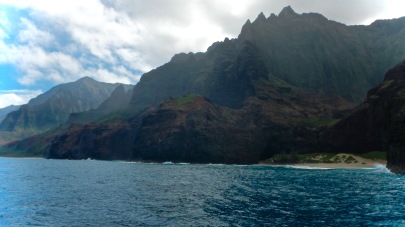 emerald green pinnacles towering over the Pacific Ocean for miles, cascading waterfalls plunging into the ocean, piercing aquamarine seas teeming with lazy turtles, happy dolphins and Humpback whales taking care of their young. I remember feeling safe as locals told us that Kauai is one of the more uncivilized and less developed islands of Hawaii.
emerald green pinnacles towering over the Pacific Ocean for miles, cascading waterfalls plunging into the ocean, piercing aquamarine seas teeming with lazy turtles, happy dolphins and Humpback whales taking care of their young. I remember feeling safe as locals told us that Kauai is one of the more uncivilized and less developed islands of Hawaii.
I left Kauai believing it was one of few untouched islands in the world only to be recently shocked and disappointed about my oblivious misconception. I was browsing the web for environmental documentaries when I stumbled upon “ĀINA, That Which Feeds Us” by Sherpa Cinemas. This short film caught my eye because I noticed that it was about Kauai and I thought it would be nice to learn a little more about the beautiful island I had such fond memories of with Francia. ĀINA is a story about how important it is to take care of our Earth, the only planet we have which nourishes us and feeds us everyday. The film clearly paints a vivid picture of the cultivation process on one small island.
Kauai is the oldest of the Hawaiian Islands and located northwest of O’ahu. On this beautiful island you will find two very extreme versions of agriculture. On one side of the island you can find local Hawaiians continuing their traditional system for growing food, which has allowed Hawaiians to live in abundance with the Earth for thousands of years. On the other side of the island you will sadly find four of the largest agro-chemical companies on the planet making this part of the island into one of most toxic chemical environments in all of American agriculture. The island is used for developing genetically modified crops and for testing ten tons of pesticides every year on these crops, poisoning the environment and local community around them.
The open air method these crops are being tested in is not allowed in other parts of the world such as Europe. These companies are spraying some of those most poisonous chemicals in the world right next to schools and local communities leaving behind toxins in the air they breathe, the water they drink, and the soil where their food is grown causing serious health issues ranging from respiratory problems to cancer.
If you look back into history you can see how Hawaii’s Polynesian descendants found the Hawaiian Islands thousands of miles away from any other land mass. They were only able to successfully find these pristine islands because they were so attuned to nature. The way these people engaged with nature with everything they did, allowed them to live in harmony with their environment.
We have this common belief that people are bad for ecosystems and that humans will never be able to live in balance with our environment therefore, there is nothing we can do about ameliorating the damage being done. I believe this is just a cheap excuse to clean your hands of the problem and to remove yourself from the situation. When the Hawaiian ancestors arrived to Hawaii, they created a relationship with nature that allowed them to live sustainably with their resources for over 1,000 years. As the documentary states, today more than 1.2 million people live in Hawaii and almost 90% of all of the food and energy to sustain that population is shipped in from other parts of the world. It’s hard to imagine that only 250 years ago, with almost the same population, zero food and energy was imported because these people knew how to live off of the land. If you take care of your resources, the resources will take care of you.
On the other side of the island you will find Hawaiians farming their land like their traditional ancestors did, it’s a complete contrast with the agro-chemical side of the Kauai. The Waipa Foundation is one example where the locals live off their land and resources using the 1,600 acre ahupua’a of Waipa, located on the north shore of Kaua’i. Waipa is a place where people can learn how to live from their resources such as kalo (taro) and a variety of other fruits and vegetables creating and continuing a healthy and sustainable environment.
The United Nations Environment Programme came out with a report called Agriculture at a Crossroads about how we’re going to feed our growing population in the future. I thought it was interesting to learn that one of the main suggestions in the report was the same way Hawaiians farmed 1,000 years ago through agroforestry, high biodiversity, and maintaining healthy and productive natural ecosystems.
As the documentary comes to a close it brings us back to the Hawaiian ancestors and how they had to be in tune to their environment to find their way to the islands. This is still true today, we have to be in tune to nature and to our growing populations if we want to be able to find our way and save the planet from environmental destruction.
“We vote every time we buy food. We vote. We vote for either sustainable, healthy food or we vote for biotech industrial ag.”
–Don Heacock, Biologist, from AINA
Bees are disappearing all over our planet and no one knows why. Honeybees pollinate $15 billion worth of food in the US alone. They are nature’s best indicator for environmental quality. What if your grocery store looked like the bottom half of this picture? Are we going to be ok with other countries producing all of our fruits and vegetables?
In the eye-opening documentary, Vanishing of the Bees, by George Langworthy and Maryham Henein, we are forced to picture a hauntingly terrifying life without honeybees. Why are bees so important? For one, they pollinate approximately one third of all of the food we eat. Some of the many crops that depend on honeybee pollination include: apples, pears, raspberries, plums, cherries, carrots, and onions. Imagine your grocery store with none of these locally grown food products available.
Throughout the documentary we explore the subtle phenomenon which beekeepers call “colony collapse disorder” or CCD? What exactly is CCD? This term is used to refer to the mass die off of bee colonies around the world. Hives with CCD show symptoms such as worker bees abandoning their hive, which is extremely unnatural, and also lack of attack by other predators such as wasps.
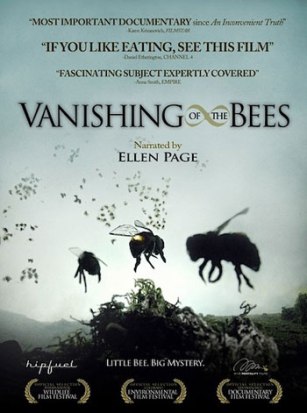 Although no one can say for certain what is causing this awful calamity, many have agreed that decades of exploiting hives may be one reason for CCD. Many commercial beekeepers will feed their bees sugar-extract or high fructose corn syrup (HFCS) after taking the honey from away from the bees. From a financial standpoint they can make more money selling the honey and buying artificial sweeteners but this money driven decision has made the bees weaker to pesticides and other chemicals they are exposed to. People may argue that sugar is sugar and that it is the same thing to the bees as honey but this isn’t true. HFCS has a different PH and it lacks the enzymes that bees receive from their natural honey.
Although no one can say for certain what is causing this awful calamity, many have agreed that decades of exploiting hives may be one reason for CCD. Many commercial beekeepers will feed their bees sugar-extract or high fructose corn syrup (HFCS) after taking the honey from away from the bees. From a financial standpoint they can make more money selling the honey and buying artificial sweeteners but this money driven decision has made the bees weaker to pesticides and other chemicals they are exposed to. People may argue that sugar is sugar and that it is the same thing to the bees as honey but this isn’t true. HFCS has a different PH and it lacks the enzymes that bees receive from their natural honey.
Many people might not realize that when you feed the bees HFCS they store it in the same cells that their nectar gets store in mixing it with their honey. So when you buy honey from many suppliers you’re getting a mixture of honey and HFCS even if the label says “pure honey”. HFCS is claimed to be toxic to bees as well as to humans.
The only beekeepers that will thrive in this industry are those that seek sustainable approaches to producing honey, approaches that respect the bees needs creating a market for clean and natural honey.
What can you do?
Write your congressmen and vote with your fork, choose organic and local, plant your own garden with plants that benefit insects such as bees, stop spraying your plants, get to know your local honey producers, and help save the bees!
This short film, México Pelágico directed by Jerónimo Prieto founder of Pelagic Life, will inspire you to seek out our ocean’s treasures and to protect and conserve its natural ecosystems. Pelagic Life is a non-profit of photographers and videographers working to capture high quality images of our ocean’s secrets. México Pelágico portrays Mexico’s open ocean through the eyes of young and enthusiastic conservationists. The purpose of this film is to show the many threats our oceans face today due to our choices and much of our dependence on its resources.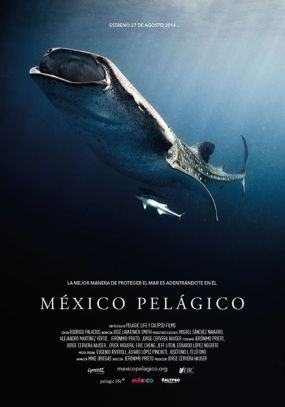
As the team travels throughout some of Mexico’s most pristine and bio diverse dive spots such as Xcalak, Playa del Carmen, Baja, Cancún, and Guadalupe Island, their main goal is to illustrate the fragility of our ocean’s health. The crew steps into the lives of many communities in Mexico that depend on our ocean’s endangered species such as sharks and tuna to make a living for their families. This unfortunate dependence on shark finning, over fishing, etc. has resulted in the overexploitation of many species in Mexico. Throughout the documentary, we see the same fishermen in these Mexican communities, who once hunted for sharks, begin working to protect these majestic animals. This gives us hope that only with simple awareness and information, many of those educational gaps can begin to close.
The film successfully illuminates the unique experiences that occur in Mexico such as Great White Shark sightings, Whale Shark migrations, and world class diving with Giant Mantas and Bull sharks. These exceptional occurrences will inspire you to engage in the underwater African Serengeti and to respect and conserve it through awareness and responsible ecotourism.
I was recently able to attend an exciting event with Texas Parks and Wildlife, National Fishing Day, at the Texas Freshwater Fisheries Center (TFFC) in Athens, Texas. On this particular day families all over Texas enjoyed a day of free fishing. Kids could enjoy learning how to fish and it was a great opportunity to spend time with family outside in nature.
The Texas Freshwater Fisheries Center, houses one of five state fish hatcheries breeding Trout, Catfish, and Largemouth bass with Largemouth bass being their primary focus producing 3-4 million fingerlings a year! The center only selects pure Florida Bass to spawn in order to maintain a higher growth gene.
The TFFC holds indoor and outdoor hatchery facilities. The indoor facilities are used for spawning, holding, and treating fish. Fish health and genetics labs are an important component of the indoor hatchery. The outdoor hatchery consists of 45 lined ponds used mainly for food production for the fish.
The center is unique in that it acts as a diverter not a consumer. All of the water used at TFFC is pumped from Lake Athens where it is filtered and treated. Once the water has been used, it is then recycled back into Lake Athens.
The Angler Recognition and ShareLunker programs act as a way to promote catch and
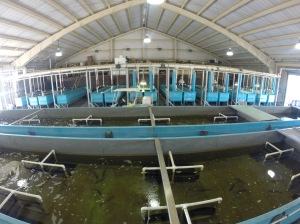
release and helps the TFFC collect data on big fish trends, habits, and behaviors. If an angler catches a fish that is at least 13lbs or larger they can lend it to TFFC and at the end of spawning season the fish will be returned to the angler for live release or the angler can donate it to the center. The angler is then invited to a banquet, receives a fiberglass replica of their catch, and ShareLunker clothing. In addition, the angler who catches the largest entry of the season is awarded a lifetime fishing license.
Few people can say they really know where Virunga National Park lies on a map and even fewer can tell you the tragedy that happened there in 2012. Virunga National Park is Africa’s oldest national park and is found in the eastern Democratic Republic of Congo. Not only is it one of the most bio-diverse places in the world, Virunga is also home to the last surviving mountain gorillas on our planet.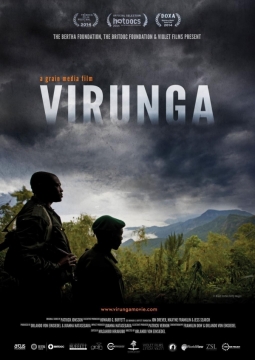
This film is about the noble fight for the protection of this UNESCO world heritage site and for the gorillas who call it their home. During political instability back in 2012, the rebel group, M23, began threatening the locals and the park rangers protecting Virunga National Park. The militia wanted the park to illegally exploit its rich resources such as oil. Eventually M23 declared war slowly moving in and opening fire in Virunga. The chaos caused some 500,000 people to flee from their homes, killed innocent park rangers, and left numerous gorillas in distress and fear. Throughout all of the bloodshed, the park rangers did not leave their post at the main headquarters in the park due to their courage and determination to protect the last surviving mountain gorillas on Earth.
“We want our children and future ancestors to have these places and species in their lives.” – André Bauma gorilla caretaker and former child soldier
Virunga is a powerful story about the courageous and honorable park rangers who risked their lives to save these majestic animals and their home. If these types of atrocities can happen in National Parks also named UNESCO World Heritage Sites, imagine what could happen at other places so near and dear to our hearts.
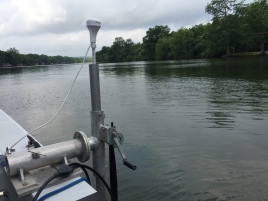 This past week I had the opportunity to go out on Lake Austin with Texas Parks and Wildlife biologists Bryan Legare and Greg Cummings and Fisheries Technician Brad Grimmett to identify the vegetation and fish biomass of the lake. The first piece of technology we used to do this was called an echo sounder, a non-invasive measure allowing us to identify what’s in the ecosystem by sending out pulses of sound that are reflected off the lake bottom and then received by a transducer. Collecting this data gives us a baseline for the vegetation and fish populations of the lake. With this information we’ll be able to recognize trends over time and see how the habitat is changing in order to better manage the lake in the future.
This past week I had the opportunity to go out on Lake Austin with Texas Parks and Wildlife biologists Bryan Legare and Greg Cummings and Fisheries Technician Brad Grimmett to identify the vegetation and fish biomass of the lake. The first piece of technology we used to do this was called an echo sounder, a non-invasive measure allowing us to identify what’s in the ecosystem by sending out pulses of sound that are reflected off the lake bottom and then received by a transducer. Collecting this data gives us a baseline for the vegetation and fish populations of the lake. With this information we’ll be able to recognize trends over time and see how the habitat is changing in order to better manage the lake in the future.
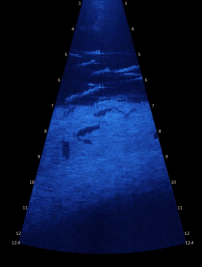
The second piece of technology we used was recently acquired within the coastal fisheries division. The Aris 3000 is an acoustic sonar equipment that converts sound pulses into high resolution digital images very similar to a medical ultrasound sonogram. Using technology like this allows us to see what’s going on underwater even in zero visibility. With this imagery we’re able to see if the recently placed brush piles by Texas Parks and Wildlife are creating favorable conditions for fish populations. Adding artificial shelters help increase fish populations which in turn increases the success of recreational fishing boosting the local economy.
Being able to learn about these complex methods and technologies from two professional coastal and inland fisheries biologists at TPWD was a great experience!
I started my new internship with Texas Parks and Wildlife this past week at the headquarters in Austin, TX! I’ll be an intern in the Executive Office but I’ll be getting a little taste of every department at TPW. My main duties with my internship consist of understanding the purpose and experiencing each division at TPW, participating in various projects and initiatives within each division, and communicating all of it back to YOU in an exciting way! I’m here to tell the stories of many people at Texas Parks and Wildlife who LOVE what they do, are AMAZING at what they do, and put passion and dedication into EVERYTHING they do. Some of the incredible projects they have me on this summer include bat cave work, aid in a prescribed fire, alligator captures and night counts, ride along with a marine game warden, and sit in on legislative hearings at the Capitol. I have a big summer ahead of me so make sure to check back for more blogs, pictures, and videos to stay updated on what’s going on at Texas Parks and Wildlife!
I’d like to share with the St. Edward’s University community a little insight on what I’ve learned from a great organization called The Online Ocean Symposium founded by Andrew Kornblatt. I met Andrew at the SXSW Eco conference in October of 2014. This online forum functions as a global space for discussion, interaction, and outreach specifically dealing with ocean issues.
Through the use of Google Hangouts on air, Andrew invites inspirational ocean leaders and representatives around the world to join a live streaming forum to talk about their individual efforts. This is a great way to bring together all of these influential leaders in policy, science, and exploration for the protection of our oceans in one space, not only to showcase their work, but also to encourage citizens around the world to take action from home.
Recently Andrew sent me the Top 5 Ocean Hangouts of 2014. Let’s dive right in and take a look at some of the most inspiring information I walked away with. Andrew put together an impressive panel for his “Our Ocean’s Conference” Hangout including Fabien Cousteau from the Aquarius Reef Base of Mission 31, Kip Evans underwater photographer of Mission Blue, Sylvia Earle, National Geographic Explorer-in-Residence and more.
Streaming live from his underwater world, Fabien stressed the importance of looking at our ocean as a Natural Resource Bank Account. Healthy oceans serve as a natural resource bank for current and future generations. Our oceans need to be highlighted and included on every front so we can begin to make the necessary strides for healthy oceans. Check out more information on Fabien Cousteau’s 3-week underwater exploration at Mission 31.
Growing up in Atlanta and now living in Austin, one question asked during the panel that struck me as very important was “How can people, who live in landlocked cities or states, take immediate action to help our oceans?” The panelists came up with a variety of solutions:
I gained great advice and learned about some exciting actions taking place for our oceans from Andrew’s “Our Ocean’s Conference” Hangout. Make sure to check out his Top 5 Ocean Hangouts of 2014 for more ocean related news and 2015 updates!
I was born in Miami into a world surrounded by family and friends, where every gathering was a celebration filled with loud music, dancing, and delicious typical Central American dishes that could last you for weeks. My father, being from Nicaragua, had moved to the United States under political asylum due to the ongoing Civil War between the Nicaraguan government and the Sandinista guerrillas during the 1980s. My mother, from Costa Rica, sacrificed her entire life to take on the full time job of raising my sisters and I with care, comfort, and boundless love that no other daycare could ever provide.
My hardworking father, worked arduous and endless hours a day to provide for his wife and three babies in a foreign country speaking a language he was still only learning. We quickly had to move from Miami to Ohio and on to Atlanta in order for my father to keep moving up in his career. Growing up in Atlanta was not easy for any of us. My parents had been ripped away from their circle of love and support of family and friends in Miami. Not to mention, in those days, Atlanta was definitely not “culturally competent,” at least not in the little bubble I grew up in called Marietta.
As I grew older, I was made fun of in school because of my accent, my hair, and my inability to learn as quickly as the rest of the American kids. I was marginalized, called names, and looked at differently. I was indeed different but I knew that at the end of the day, as human beings, we all have more commonalities than our differences. Out of resentment towards all of those people who treated my family and I differently, I made it my mission in life to become even more worldly and eccentric as I already was, accepting and learning from every culture that touched my life.
I went on to study in Florence, Italy for an entire year during my first year of college where I picked up a third language and immersed myself completely in the Italian culture. I received my Bachelor of Science in International Affairs and Italian from Florida State University. Upon graduating, I decided to go work in Costa Rica and Nicaragua with three turtle conservation internships. During my time with these programs, I engaged with people from all over the world with the single mission of protecting this endangered species and educating the local communities we lived in.
After three months in my parent’s countries, I moved back to Atlanta for a year to work at CNN as a tour guide. Here, I interacted with hundreds of people everyday from all over the world and I was able to contribute my time in CNN Español and CNN International learning as much as I could from each department. During my time at CNN, I became fascinated with the fact that my passion for ocean conservation awareness could easily reach people all over the world through media, film, and photography. Knowing the importance of a master’s degree, especially for my field of interest, I decided that it was time for me to go back to school.
I am currently in my first year of the Professional Science Master’s (PSM) in Environmental Management and Sustainability at St. Edward’s University in Austin, Texas. Through this program I will have the opportunity to complete the second year of my master’s in Angers, France absorbed in Europe’s progress in sustainable development and learning a fourth language.
Every opportunity that has been given to me in life would never have been possible without the courage, support, and determination my parents instilled in me as a baby. Prideful of my Hispanic heritage and knowing how challenging their lives were moving to a foreign country, my mother and father have always been my saving grace and my shining light at the end of every dark tunnel. Their admirable journey to succeed in America is what reminds me to continue riding my wave of making the world a better place.
Gracias mami y papi… sin la inspiración y apoyo que me han dado toda la vida, no sería la mujer que soy ahora.